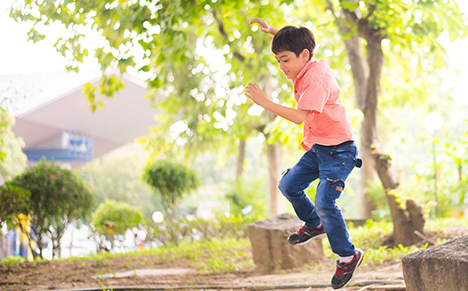When your body receives sensory information, your brain processes it and determines the appropriate response. For example, when you hear your name being called, you look up. When you touch something hot, you instinctively pull your hand away. This is part of the body’s natural process for self-regulating. However, kids with a sensory processing disorder (SPD) may not be able to self-regulate, and instead, display inappropriate motor responses when their sensory system is overloaded.
Why Do Kids Flap or Jump?
Hand flapping and jumping are common motor responses among children with autism or other SPDs. These extraneous movements are a way for their bodies to cope with sensory overload and filter information. In fact, if you ever do something like tapping your foot on the floor when you feel uncomfortable, you are displaying a more subtle form of flapping or jumping.
These behaviors aren’t always disruptive but there are times when they are inappropriate. Sometimes the behavior becomes pleasurable and creates a feedback loop. These kids may jump initially as a result of sensory overload, but then they enjoy jumping so much that they continue doing it. Offering replacement behaviors may help break the repetition. Below are some examples of common replacement behaviors you can try out at home.
1. Offer Alternative Input
You can refocus your child’s attention by providing different input. For example, offset hand flapping by redirecting their hands to a different activity. Arts and crafts or sensory bins are great ways to keep hands busy. You can also offer putty, fidgets, or even a soft lap pad for soothing tactile input.
Another method is to offer stimulation through different sensory channels. Try chewies for oral input, aromatherapy for olfactory stimulation, or a swing for vestibular input. Cognitive activities such as counting by fives, catching a ball, or reading out loud are also helpful options.
2. Get Moving
You might think that kids who hand flap or jump get enough movement in their day, but it could actually be a sign that they’re not. Make sure that there is enough active movement throughout the day to help your child continue to filter sensory input. Work with your child’s occupational therapist to determine the best sensory diet for them. This can help reduce their need to jump or flap when they’re feeling overwhelmed.
3. Watch and Learn
Implement one strategy at a time and observe when your child displays more or less of the extraneous movements. Keep track of each strategy’s effectiveness so that you can determine the best ones for your child. This will require an abundance of patience but it will be worth the effort as you empower your kids to self-regulate!
Do your children flap their hands or jump? How do they cope with sensory overload? Share your strategies and experiences in the comments! Have any questions? Reach out to us at customercare@funandfunction.com.
Check out our variety of calming tools to reduce sensory overload.
This post was originally posted on 11/07/2019 by . It was updated for accuracy and comprehensiveness on 12/15/2021























Comments